With EMS PCBA services, you can have electronics manufacturing by a third-party manufacturer. You can save enormous resources and costs because you don't have to build production lines and hire and manage workers anymore. And you can upgrade products without considering fabrication capabilities. All you need is to keep your R & D capability and brand marketing.
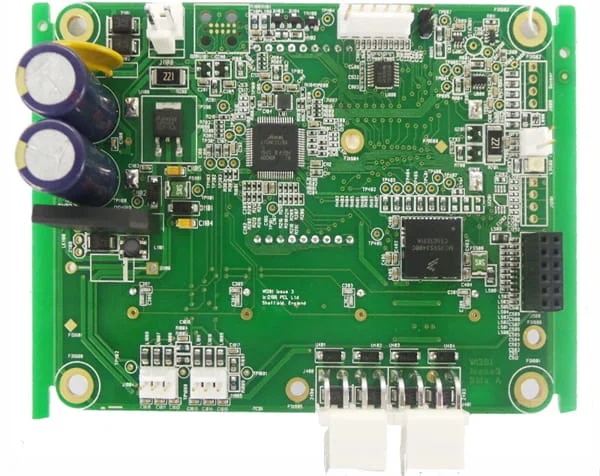
This article reveals EMS PCBA and how can you have EMS PCBA manufacturing without hassle at one stop.
Part 1: What is EMS PCBA
EMS stands for electronics manufacturing services, and PCBA stands for printed circuit board (PCB) assembly, which is a semi-finished product custom-made for all modern electronic devices.
EMS PCBA means one-stop electronics manufacturing, including PCB fabrication, PCB assembly, component sourcing, EMS PCBA value-added, and PCBA box-build assembly.
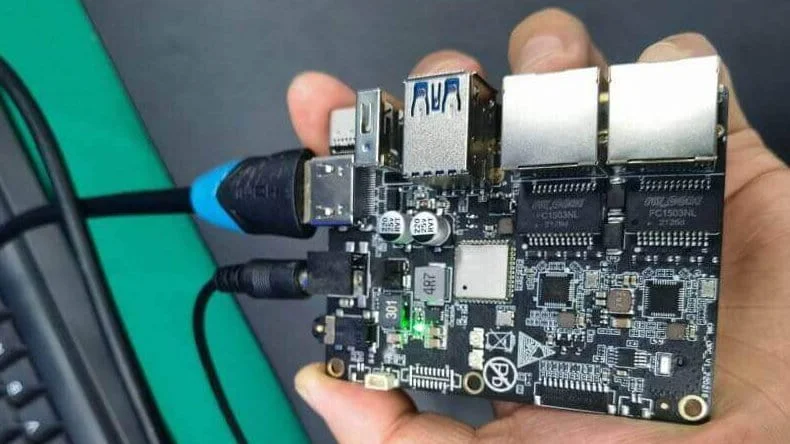
EMS PCBA manufacturing is flexible production. That means, you know every detail of the EMS assembly project and you can start, pause, or change the project at any time, and the EMS PCB manufacturer provides technical support and manufacturing capabilities to meet your demands and ensure the EMS PCBA is a success.
In an EMS PCBA project, you don't have to design the PCB and product enclosure. The EMS PCBA manufacturer has the R&D (research and developing) capabilities and can provide the entire design according to your requirements.
In PCBA EMS manufacturing, PCBs or printed circuit boards are manufactured according to the PCB design, and the EMS PCBAs are created by mounting electronic components on the PCBs. After EMS PCB assembly, the PCBA is further assembled or laminated to other components to become a module or system.
For example, you can see the PCBA EMS manufacturing of the battery cell contact system.
The EMS manufacturing project includes the enclosure design and manufacturing. You can design it or ask the EMS PCBA manufacturer to do it. When the PCBA is assembled with the matching enclosure, you get a finished electrical product.
Compared with turnkey assembly, EMS PCBA manufacturing has a wider range, as it includes not only PCB fabrication and assembly but also R&D, enclosure manufacturing, PCBA value-added, and box-build assembly. Whether you have a design or not, you can work with a reliable EMS PCBA manufacturer, such as PCBONLINE, to provide contract manufacturing for you.
Part 2: What to Provide to an EMS PCBA Manufacturer
What data or materials do you provide to an EMS PCBA manufacturer for PCBA EMS manufacturing?
1. Gerber
A Gerber is generated automatically from a PCB design software when you complete a PCB design. It is a universal PCB design compressed file, which contains a Gerber file folder and a drill file folder.
In the Gerber folder, each PCB layer (solder mask, circuit layer, prepreg, substrate, and silkscreen) corresponds to a graphic file.
The drill file enables the EMS PCB manufacturer to know what, where, and how the PCB holes are drilled. The types of PCB holes include NPTH, PTH, buried vias, blind vias, etc.
2. Bill of materials (BOM)
![]()
A BOM is a component list that contains all information on electronic components for EMS PCBA assembly, including the component reference, quantity, footprint, part number, manufacturer name, and manufacturer part number (optional).
If you have the R&D capabilities, in the EMS PCBA project, you can provide the product design, including the Gerber file for PCB design, and BOM (bill of materials) that lists the information of components on the PCBA. Gerber and BOM are the necessary files for EMS PCBA manufacturing.
Apart from Gerber and BOM, you can provide the below files or things to your manufacturer to conduct EMS PCBA manufacturing.
- Pick-and-place file — A pick-and-place file lists the references of the components on the board so that the EMS manufacturer can compare the real PCBA with it. This file can also be generated by your EMS manufacturer.
- Assembly drawing — An assembly drawing shows the estimated PCB assembly.
- 3D drawing — A 3D PCBA drawing displays the three-dimensional outlook of the estimated PCB assembly.
- Enclosure design or specifications — If you have the enclosure design matching the PCBA, please also share it with your EMS PCBA manufacturer so that it can check and fabricate the enclosures.
- Software for IC programming — Before or after surface mounting the IC on the PCB, you may need to transfer the program into the IC. The EMS PCBA manufacturer PCBONLINE understands the protection of intellectual property. If you don't want to send the software, PCBONLINE provides to temporarily open an Aliyun Cloud for you, and you can transfer the software through Aliyun to the IC without downloading it on the computer of PCBONLINE. Besides, PCBONLINE can design the software for your product as well.
- Testing file — It is used for finished product testing, including testing methods and procedures.
You don't have to provide the product schematic to the EMS PCB manufacturer as it is confidential for an electronic product design.
If you do not have the EMS PCBA design, no worries, the EMS PCBA manufacturer PCBONLINE can design the EMS PCB and product for you.
![]()
Part 3: EMS PCB Manufacturer PCBONLINE
PCBONLINE, an EMS PCBA manufacturer founded in 1999, provides product R&D, PCB design, PCB prototype, PCB manufacturing, PCB assembly, and value-added services, such as conformal coating, IC programming, mechanical boxes, and box-built.
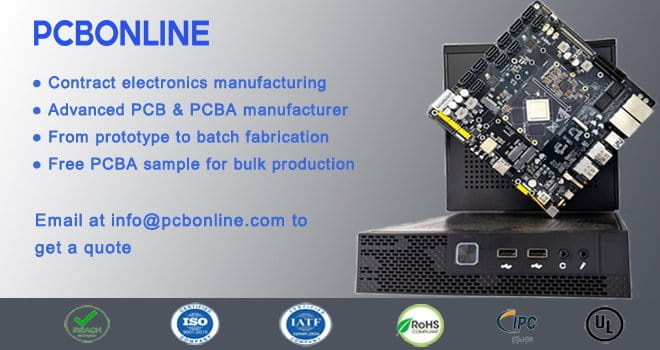
PCBONLINE provides EMS PCBA manufacturing at one stop, including R&D, prototyping, PCB manufacturing, PCB assembly, EMS PCBA value-added, and box-build assembly.
PCBONLINE provides EMS PCB assembly without a minimum quantity limit.
For bulk EMS PCBA manufacturing, PCBONLINE can provide product R&D, samples, and PCBA functional testing for free.
PCBONLINE has strong EMS PCB assembly capabilities, including 3D SPI, 3D AOI, 3D X-ray, the Plasma process, etc.
Affordable and traceable EMS PCBA manufacturing, including the components, PCB materials, solder paste, PCB fabrication and manufacturing process, testing, and package.
EMS PCBA manufacturing is certified with RoHS, IATF 16949, ISO 9001:2915, REACH, UL, and IPC.
The EMS PCB manufacturer PCBONLINE has many successful cases, such as the R&D and EMS manufacturing of projectors, cell contact systems for lithium-ion battery packs, false eyelash UV disinfection boxes, etc. It has capabilities and experience in EMS PCB assembly for automotive, medical, aerospace, defense, communication, and consumer electronics. If you want to get a quote for EMS PCBA, contact PCBONLINE by email at info@pcbonline.com.
Part 4: EMS PCBA Manufacturing at One-Stop
Below is how can you have EMS PCBA manufacturing from the beginning to product delivery.
PCB Design
When you design a PCB, you will draw schematics, design the stack-up, size, and layer number, and set up the routing width rules, fanout control rules, routing via style rules, routing layers rules, and electrical clearance rules. You will follow some design rules - placing big and main components first and in the center with small components around, fanout the big and main components first, and separating analog and digital signals...
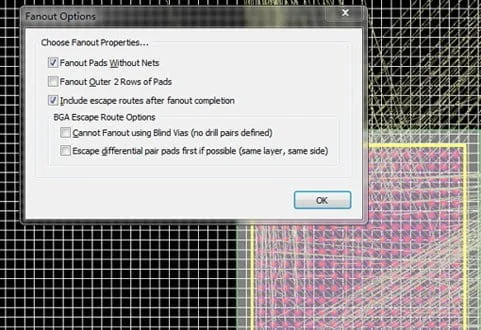
The wires will route automatically based on the rules you set up. When it completes, you will check the wire routing.
If you need help in PCB design, please feel free to contact PCBONLINE in your early development phase. Our CAM engineer with 20+ years of experience will provide you with one-on-one assistance.
Once you receive your Gerber, the manufacturer PCBONLINE will review it to make sure your design can be fabricated in theory.
PCB Prototype
The PCB design is only theoretically feasible, but in fabrication, even a small detail that we didn't consider can fail the product. Before batch EMS PCBA production, the manufacturer PCBONLINE will prototype first.
![]()
By prototyping, we can test out our ideas and different materials until we finally get the optimal design and successful samples.
Please note that if you order bulk EMS PCBA from PCBONLINE, we will offer you a free PCBA sample, including PCB prototyping, prototype assembly, and the electronic components for it.
EMS PCB Manufacturing
PCBONLINE has two large advanced manufacturing bases, and we can fabricate FR4 PCB, flexible PCB, rigid-flex PCB, metal core PCB, high-frequency PCB, AlN PCB, alumina PCB, and hybrid PCB.
The PCB fabrication process includes the below steps (take FPC fabrication for example):
Process FPC copper and coverlay fabrication
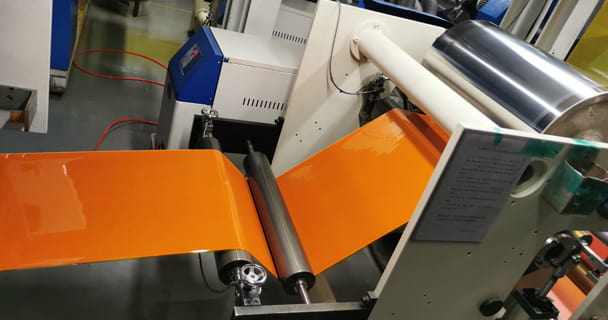
We press the ED or RA copper foil, polyimide (PI), and adhesive to the required thickness. And we laminate the PI and adhesive to make the FPC coverlay.
Laminate fabrication and drilling
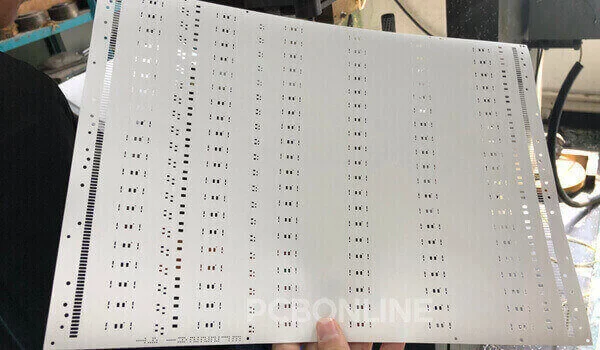
We laminate the ED or RA copper foil with coverlay to fabricate the FPC laminates. Then we drill on the laminates and coverlays.
VCP electroplating and circuit image transfer
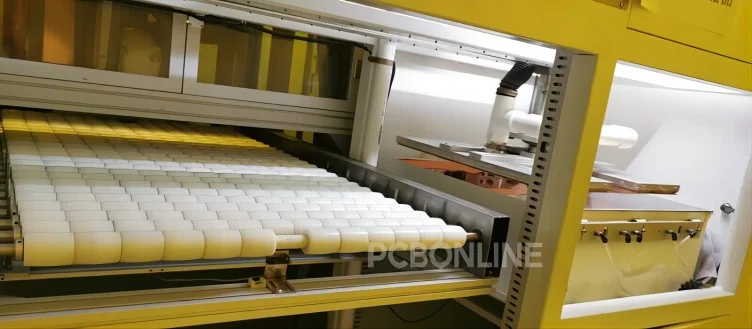
On the VCP line, we electroplate the PCB through holes. Then, we transfer the circuit image on the copper foil by UV exposure.
Circuit etching and drilling positioning holes
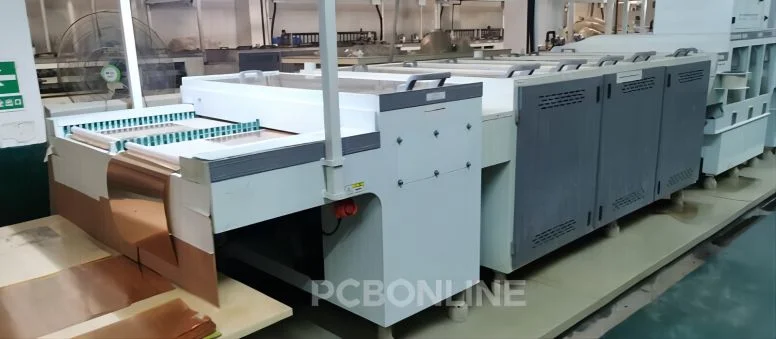
On the circuit etching line, the unwanted copper is chemically removed, and the copper foil becomes circuit layers.
Then we drill positioning holes on the laminates and coverlays so that the board can be laminated and assembled efficiently.
Electrical testing and cleaning of FPC
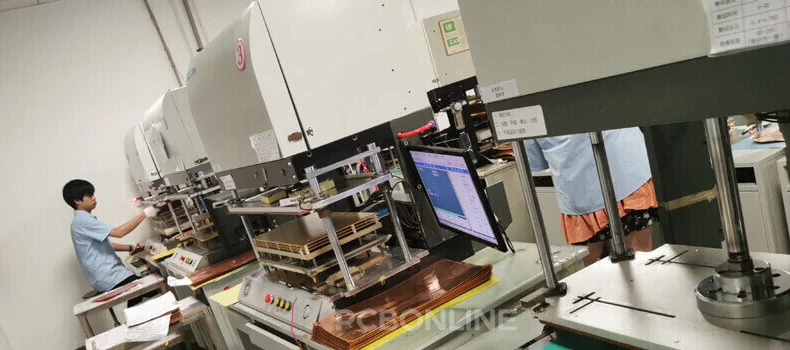
After etching, we conduct an electrical test on every circuit layer. Later, we clean and scrub the FPC laminates to increase the gloss.
FPC lamination, silk screen, and baking
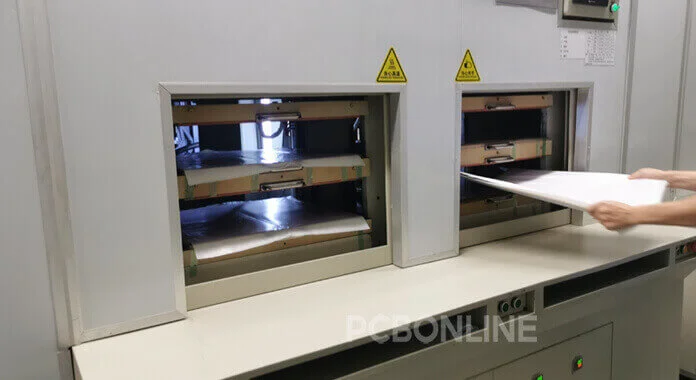
Later, we stack the laminates and coverlay according to your PCB stack-up and laminate them at high temperatures. Then we print PCB inks on the FPC for silkscreen. Later, we bake the FPC boards.
Surface finish, electrical test, and profiling FPC
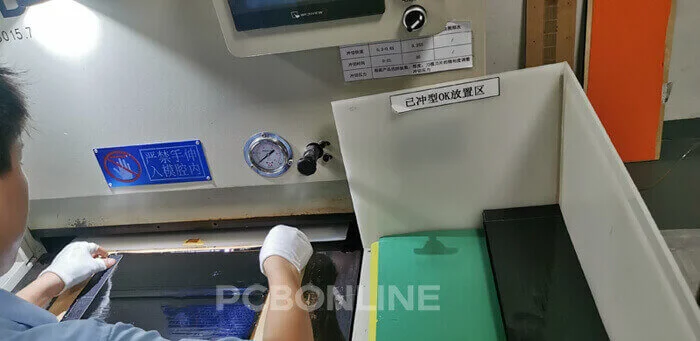
Next, we apply the surface finish according to your requirements and conduct an electrical test on the boards.
Then we form the finished FPC boards by cutting the rail edge by cutting dies and steel dies.
Visual inspection and sample testing
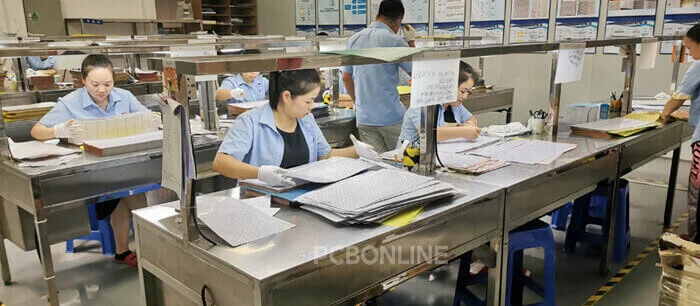
Finally, we conduct a visual inspection on all FPC boards and randomly pick up 10% of the boards for sampling testing.
If all samples pass the testing, then we package the boards. If even a sample board fails in testing, we test all the rest FPCs to ensure the circuit board quality.
Sourcing electronic components
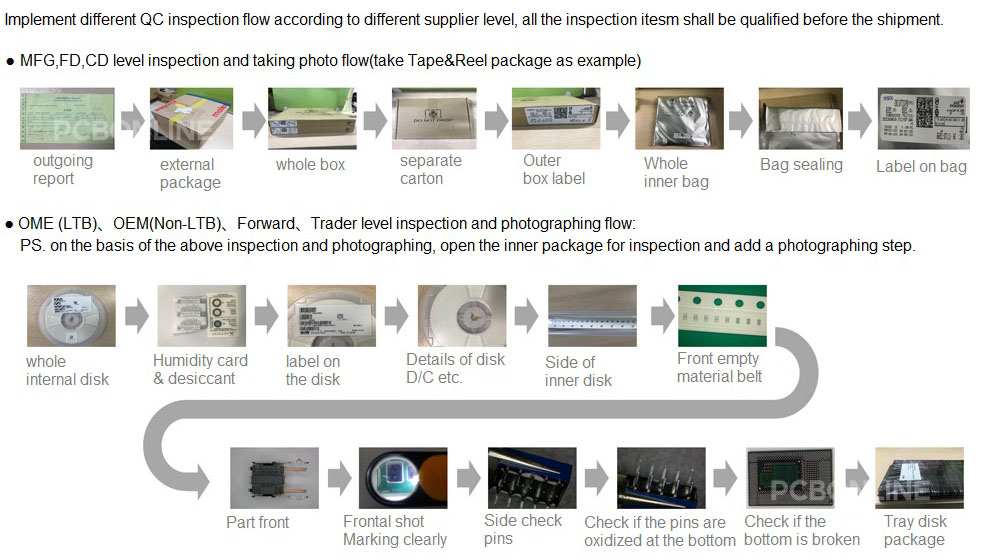
Once you place the EMS PCBA order, we start sourcing electronic components. It takes about 15 to 45 days for PCBONLINE to source all passive and active components for PCB assembly.
Relying on our EMS production factory, we can enjoy direct supplies from the original factories and enjoy discounts by co-procurement with other large EMS.
Besides, we have long-term strategic cooperation with authoritative suppliers, such as Digi-Key and Mouser.
If you want odd components, we can also have them manufactured from local factories in Shenzhen.
All the suppliers have been audited by us. For ICs, we conduct a counterfeit test to make sure they are real ICs.
EMS PCB Assembly
At PCBONLINE's PCB assembly factory, both SMT and THT assembly are available. Before bulk PCB assembly, we assemble five pieces first and randomly choose one PCBA for the first article test. We will generate a PCBA sample testing report for you to review and approve bulk PCBA production.
The SMT PCBA manufacturing process is below.
Solder paste printing and inspection
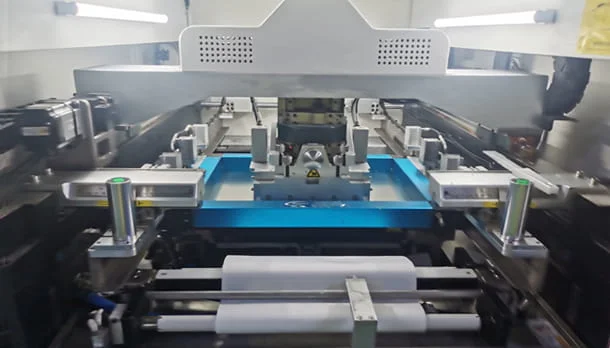
A solder paste machine is the beginning of an SMT line. At first, a feeder automatically sends the PCBs into the solder paste printing machine, which has already been placed with an SMT stencil. The scraper of the machine presses the solder paste to go through the stencil holes to "print" on the PCB pads.
Later, the PCB is automatically sent into a solder paste inspection machine to make sure the solder paste positions, shapes, and sizes are qualified.
Surface-mount SMDs on PCBs and BGA X-ray inspection
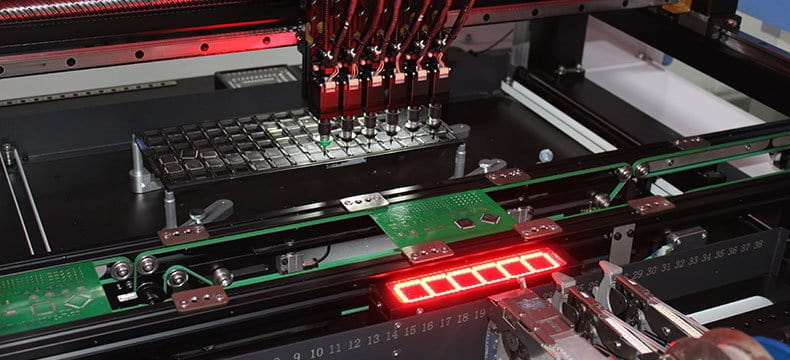
On the SMT line, the PCBs are one by one sent into the high-speed and functional surface mounting machines, in which the SMDs are pick-and-placed on PCB pads.
If your PCBA has BGAs, we have to use an X-ray machine to inspect the solder balls under the BGA before reflow soldering.
Reflow soldering and AOI inspection
![]()
The PCBAs are automatically transferred into a reflow soldering oven with 10 temperature zones, where the boards are preheated, reflow soldered, and cooled down. The moisture and flux of the solder paste evaporate. The alloy powders in the solder paste and BGA solder balls gradually melt and bond the PCB and SMDs and cure.
Later, the PCBAs pass the automatic optical inspection (AOI) machine one by one. The AOI makes sure there are no surface issues, such as bridges, insufficient soldering, SMD offsets, skew, and missing.
After the SMT assembly, if the PCBAs need THT assembly, they will be assembled on the THT assembly lines.
Through-hole mounting and wave soldering
![]()
We manually insert the pins of through-hole components through the PTHs and deliver the PCBAs into a preheating machine. The preheated PCBAs are automatically transferred in a wave soldering machine, in which liquid tin fills the gaps between the pins and PTH hole walls.
Then we trim the pin length to be within 2mm and visually inspect the PCBAs. Then we clean the PCBAs.
For many manufacturers, the PCBA production ends now, and they will send you the PCBAs. However, the EMS PCBA manufacturer PCBONLINE continues working in the post-assembly phase.
PCBA Post-Assembly Phase (Field Application Engineering)
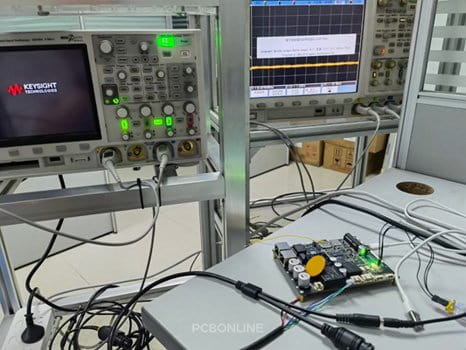
After PCB assembly, we conduct functional jig testing on all the PCBAs to make sure the product works as expected. To avoid possible issues during the FAE (filed application engineering) stage, if you would like, we can join your R&D in the early developing stage.
And we provide the below value-added services.
- IC programming- we have standard IC programming jigs and can transfer the program into the ICs on circuit boards freely for you. However, you will need to provide the program. Suppose you don't want your EMS PCBA manufacturer to download your program. In that case, you can give us a cloud interface, which allows you to control and monitor every program transfer from the cloud to the IC without downloading to the local of our computer.
- Conformal coating- we can apply conformal coating on the PCBAs to provide better protection and extend the lifespan of the electronic and electrical products.
- Thermal aging testing- we can let the PCBA power on continuously for 48 hours or more to make sure your electrical products perform well for a long working period in use.
- Box-built assembly- we can design the mechanical box according to your requirements and have them manufactured by local factories in Shenzhen. Later, we assemble the PCBAs with the corresponding mechanical boxes. Finally, we will conduct finished product testing to make sure the box-builds work normally. And we package and have them shipped to you.
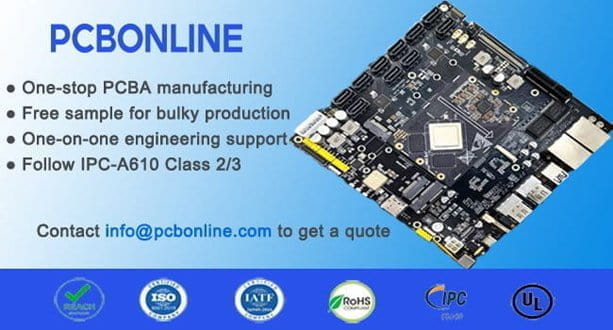
All EMS PCBA prices for the paid services will be listed on the quotation order from PCBONLINE. Our CAM engineer will provide free one-on-one engineering assistance throughout the project. Besides, in this fourth quarter, PCBONLINE will provide 35% off for bulk PCB fabrication and 15% off for EMS PCBA orders. You can contact PCBONLINE by email at info@pcbonline.com to activate this promotion.
Conclusion
EMS PCBA manufacturing can be easy, quick, safe, and hassle-free. This article illustrates how you can have EMS PCBA manufactured saving time and energy. By working with the one-stop EMS manufacturer PCBONLINE, you can save big and harvest high-quality products.
© This article is an original work of the PCBONLINE team. Please indicate the author PCBONLINE if you reprint. If the article is reproduced without permission or indicating the author's source, PCBONLINE reserves the right to investigate the infringement.




